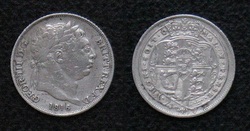Currency during the Regency
What's a quid? What's the difference between a guinea and a sovereign? Georgian-era currency is a fascinating study. During the Regency, British money was expressed as pounds (£), shillings (s.), and pence (d.)
£1 = 20s. = 240d.
£1 = 20s. = 240d.

George III sixpence, 1816. Public Domain
Currency Under a Pound
2 farthings = 1 halfpenny (“hay-p’ny”)
2 halfpence = 1 penny (1d, also called a copper)
2 pence = 1 half groat or twopence (“tuppence,” as in Mary Poppins’ “Feed the Birds” song) (2d)
3 pence = 1 threepence (or “thruppence,” or joey) (3d)
4 pence = 1 groat (4d)
6 pence = 1 sixpence (a tanner) (6d)
12 pence = 1 shilling (a bob) (1s)
2 shillings = 1 florin ( a two bob bit) (2s)
2 shillings and 6 pence = 1 half crown (2s 6d)
5 shillings = 1 Crown (5s)
10 shillings = a half-sovereign
10 shillings 6 pence = a half-guinea
Pounds and Such
£1 coin minted after 1817 was called a Sovereign and was made of gold.
A quid was a paper pound.
1 guinea = £1-1s-0d ( £1/1/- ) = one pound and one shilling = 21 shillings. Guineas were considered more refined than regular pounds. The lower classes were paid in pounds.
2 farthings = 1 halfpenny (“hay-p’ny”)
2 halfpence = 1 penny (1d, also called a copper)
2 pence = 1 half groat or twopence (“tuppence,” as in Mary Poppins’ “Feed the Birds” song) (2d)
3 pence = 1 threepence (or “thruppence,” or joey) (3d)
4 pence = 1 groat (4d)
6 pence = 1 sixpence (a tanner) (6d)
12 pence = 1 shilling (a bob) (1s)
2 shillings = 1 florin ( a two bob bit) (2s)
2 shillings and 6 pence = 1 half crown (2s 6d)
5 shillings = 1 Crown (5s)
10 shillings = a half-sovereign
10 shillings 6 pence = a half-guinea
Pounds and Such
£1 coin minted after 1817 was called a Sovereign and was made of gold.
A quid was a paper pound.
1 guinea = £1-1s-0d ( £1/1/- ) = one pound and one shilling = 21 shillings. Guineas were considered more refined than regular pounds. The lower classes were paid in pounds.